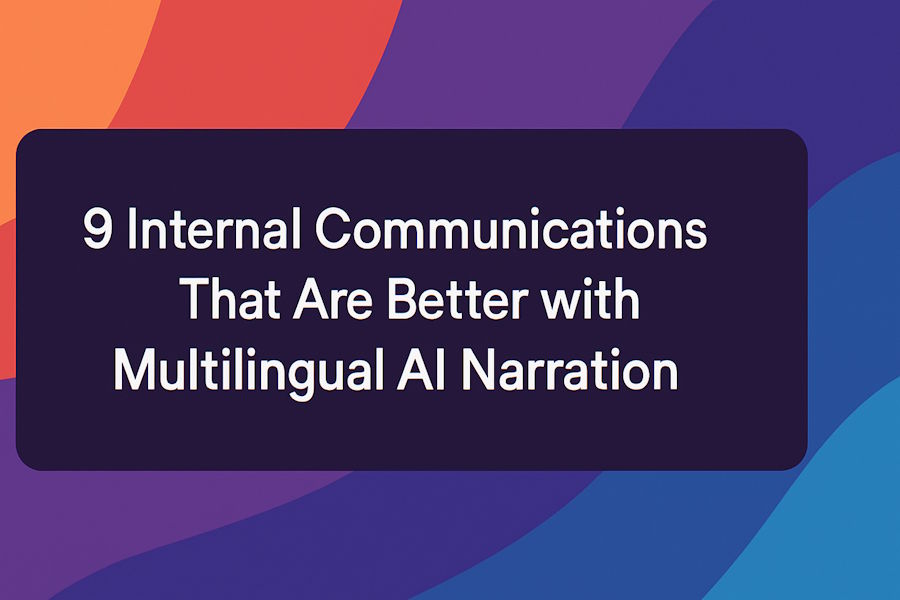Internal communication is one of those things you don’t think much about—until it becomes a problem. Maybe it’s a memo that gets misunderstood, or a video that nobody watches, or a safety update that doesn’t land where it needs to. Now, imagine trying to make that same communication work across offices in São Paulo, Tokyo, Berlin, and Atlanta. The stakes go up, and suddenly the language barrier becomes a real obstacle. Enter multilingual narration powered by AI. Not as a gimmick, but as something surprisingly human in its ability to connect people who speak completely different languages in completely different time zones—without slowing anything down.
What’s quietly happening behind the scenes in more global companies is the steady replacement of long-winded email chains and dry internal memos with something that actually sticks: voices. Not just any voices, but ones that sound natural, are localized, and come delivered in a matter of minutes thanks to AI. These voiceovers don’t just add polish—they replace friction. And when that happens, things move faster, people feel more included, and communication becomes less of a hurdle and more of a superpower.
Training Videos Become Personal and Accessible
Training is one of those areas where companies pour time, money, and effort—but often leave half the team struggling to keep up. It’s not always the material that’s the issue. It’s the way it’s delivered. Watching a training video in a second language (or worse, reading subtitles while trying to follow a demo) can create the kind of cognitive overload that just makes people check out. But when the same training comes with multilingual narration that feels like a native speaker is walking you through the steps, something clicks. You can focus, absorb, and retain more.
This is especially helpful for safety training, compliance walkthroughs, onboarding sessions, and anything that needs everyone on the same page. When a company is growing and onboarding dozens (or hundreds) of new people across regions, the cost of misunderstanding can be high. Narration helps ground people. It turns passive viewing into active learning. It lowers the barrier to comprehension. It makes training feel like something people want to do instead of something they’re forced to get through. That one change can mean better results from the start.
Company Updates That Actually Get Watched
Let’s be honest. Most internal updates feel like corporate homework. A lot of people open the email, skim the first line, and click away. Even when those updates are important, they often fail to land. But when leaders record a message—or better yet, use multilingual narration to deliver the message in a voice and tone that matches their intent—people pay more attention.
It’s not just about making things “sound nice.” It’s about making sure people hear the message in a language that hits home. When your team in Mexico hears the update in fluent Spanish, and your team in Singapore hears it in fluent Mandarin or English, the information feels personal. It feels like you thought about them. AI helps your business grow because it reduces the friction between what you say and what your people hear.
This kind of connection leads to higher engagement. That engagement builds trust. And when trust builds, your team feels more aligned—especially during big changes, like restructuring, launching new products, or going through mergers. Instead of leaving people in the dark or making them rely on poorly translated emails, you deliver a direct line of communication that cuts through.
Leadership Messages That Feel Personal, Even From a Distance
Executive messaging can easily fall flat. A CEO might send a message meant to inspire, but if it’s written in stiff English and read by someone in a totally different region, it often gets lost in translation—literally and emotionally. Now imagine that message delivered by a video generator from AI that matches tone, inflection, and even facial expressions if needed, and does it all in the listener’s native language. It doesn’t just “get the job done.” It feels personal.
Executives already struggle to seem relatable in large organizations. AI narration helps bridge that gap, especially when they need to speak to a global workforce without sounding robotic or disconnected. The result is a leadership presence that feels more human—even if it’s being generated from a script and delivered across the world.
This isn’t about replacing real leaders. It’s about enhancing how they’re heard. Think of it as putting a voice to intent. And the more accurately that voice reflects the language and emotion of the team listening, the more effectively that message will land.
Human Resources Communications That Are Actually Human
HR might have one of the hardest jobs in communication. They’re often the ones delivering policy updates, benefits explanations, and sensitive information. That gets tricky when your workforce is multilingual and multi-generational. An email about health insurance or time-off policies in corporate-speak just doesn’t cut it when half your team isn’t reading in their first language—or at all.
This is where AI avatar applications start to shine. HR can now deliver messages in multiple languages, with tone and clarity that are consistent across the board. But beyond just the voice, avatars bring something visual and dynamic to the table. Employees don’t feel like they’re getting another corporate memo. They feel like someone is talking directly to them.
That emotional response matters. Especially when the topics are personal—like mental health resources, family leave, or pandemic-related policies. An AI avatar that speaks your language and looks like it was made for your team, not a generic template, makes the message more trustworthy. HR starts to feel like an extension of your community, not just the enforcer of policy. It’s not magic. It’s just communication done better.
Departmental News That Doesn’t Get Lost
A lot of internal communication happens at the department level—IT sharing new password protocols, marketing rolling out a brand update, finance explaining a new expense system. But when teams are global, and not everyone checks Slack or email at the same time—or in the same language—those updates slip through the cracks.
Multilingual narration solves that by meeting people where they are. You don’t need everyone to read a paragraph about software changes. You just need them to hear it, understand it, and act on it. And when you layer in natural-sounding voiceovers that get to the point fast, it’s easier for employees to stay in the loop.
These updates don’t need to be dramatic. But they do need to be consistent. When people know that a quick, easy-to-understand voice note is coming their way, they’re more likely to pay attention. That’s how habits form. And when those habits form around internal communication, everything from compliance to creativity gets better.
Onboarding That Doesn’t Feel Like Drowning
Anyone who’s ever started a new job knows that the first few days are a blur. Now picture that same blur in a second or third language. It’s overwhelming. But it doesn’t have to be.
When companies use multilingual AI narration to build out onboarding flows, they’re not just being nice—they’re being smart. New hires don’t have to translate every form or decipher every video. They get clear explanations, step-by-step walkthroughs, and a welcome that feels like it was made for them. That’s powerful.
And it sets the tone early. If a new employee feels like the company invested in helping them understand from day one, they’re going to feel more confident, more loyal, and more willing to engage. The opposite? Confusion, silence, and turnover.
IT Instructions That Actually Get Followed
There’s a special kind of pain reserved for trying to follow IT instructions that make no sense in your language. Whether it’s setting up two-factor authentication, installing required software, or rebooting something after a security update, people get frustrated fast. And frustrated employees don’t follow through.
Voiceover helps fix that. Hearing a clear explanation in your own language reduces the time you spend asking for help. It also reduces the time IT spends responding to the same questions over and over. Multiply that by hundreds—or thousands—of employees, and the impact adds up fast.
It’s not about dumbing things down. It’s about smartening things up. Clearer communication means fewer errors, faster implementation, and better security. And no one has to read a five-paragraph email just to reset a password.
Culture and Inclusion Initiatives That Feel Real
It’s one thing to say your company values diversity and inclusion. It’s another thing entirely to make sure every team member feels seen and heard. Multilingual narration makes inclusion visible. Not through token gestures, but through everyday communication.
Whether it’s a message celebrating a cultural holiday, a company-wide update on DEI progress, or a shoutout in a weekly roundup, making sure everyone hears it in their language makes the gesture feel real. It says: We see you. We want you to understand. You matter.
That kind of internal equity builds culture. And culture builds teams that stick around, work better together, and perform higher across the board.
Emergency Alerts That Save Time and Protect People
When something goes wrong—a fire drill, a weather alert, a sudden policy change—speed matters. But so does clarity. If you’re relying on text messages or emails in a single language during a crisis, you’re creating unnecessary risk.
Voiceover narration can deliver emergency instructions instantly, in multiple languages, with no guesswork. People hear what they need to do, and they do it. There’s no pause to translate. No confusion. Just action.
And when the emergency is over, those same tools can be used to debrief, reassure, and rebuild trust. Because the way you communicate in crisis shapes how your team feels afterward.
Your company may already be using AI for customer-facing tasks. But the internal potential is just as game-changing. When you start speaking your team’s language—literally—you unlock understanding, speed, trust, and alignment in a way that no memo ever could. And that might be the smartest thing you do this year.








